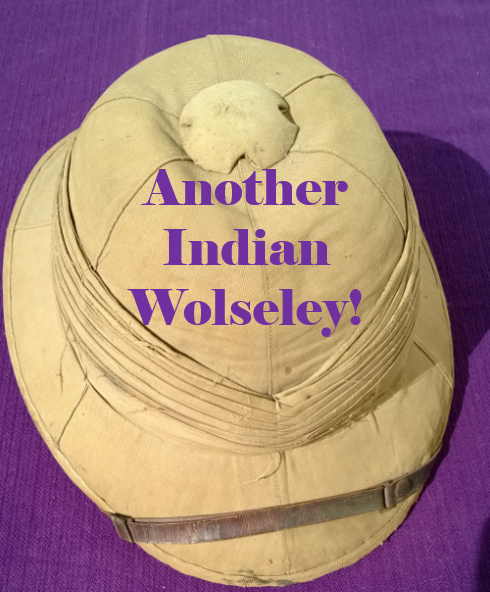 One of the great misconceptions of Japanese tropical headgear of the Second World War is that the pattern known to collectors as “English,” “safari” or “European” was in fact produced outside of Japan. This is likely based on the fact that the helmets are similar in shape externally to the various Indian pattern helmets but also because the maker labels inside are in English. Continue reading
One of the great misconceptions of Japanese tropical headgear of the Second World War is that the pattern known to collectors as “English,” “safari” or “European” was in fact produced outside of Japan. This is likely based on the fact that the helmets are similar in shape externally to the various Indian pattern helmets but also because the maker labels inside are in English. Continue reading
Category Archives: Pith
Another Indian Wolseley
Wolseley helmets made of sola pith are indeed rare things. One was described on this website and Chis Mills has shown one in his book*. My reason for presenting a third one now is that it offers some more and different detail, which might give some clues to the circumstances and time of its manufacturing and indeed, proof of its use as a military helmet.
An Indian Wolseley?
 The story of the Wolseley helmet is well documented, but occasionally even we come across something a little different. In this case it is a helmet that has the basic shape of a Wolseley and at first glance could possibly be dismissed as a “child’s helmet.”
The story of the Wolseley helmet is well documented, but occasionally even we come across something a little different. In this case it is a helmet that has the basic shape of a Wolseley and at first glance could possibly be dismissed as a “child’s helmet.”
The story gets interesting however. This helmet, which is a bit of a cross between a Wolseley and a polo style helmet, was apparently made in India. Moreover, while we have noted that the English helmet makers principally worked in cork with the Wolseley – with straw and felt also serving when there were shortages of cork – this Wolseley style helmet is made of sola pith!
The Bombay Bowler
The Bombay Bowler (BB) is often confused with the Cawnpore Tent Club and Khaki Solar Pith Hat, in fact the latter two are often confused with each other. However, the Bombay Bowler is considerably smaller than the other two. Continue reading
Khaki Sola Pith of the XII Army
 The Twelfth (XII) Army actually existed twice during the Second World War – although the first time it was created as a fictional formation as a Cairo-based deception department. Created by Dudley Clarke as part of the deception plan for Operation Husky, the Allied invasion of Sicily in July 1943, it was intended to have the Germans believe that the Twelfth Army was going to land in Greece and then advance into the Balkans.
The Twelfth (XII) Army actually existed twice during the Second World War – although the first time it was created as a fictional formation as a Cairo-based deception department. Created by Dudley Clarke as part of the deception plan for Operation Husky, the Allied invasion of Sicily in July 1943, it was intended to have the Germans believe that the Twelfth Army was going to land in Greece and then advance into the Balkans.
The army’s formation insignia was a trained seal balancing on its nose a terrestrial globe, which is obviously quite different from the above example. This is because in May of 1945 the phantom Twelfth Army was disbanded and a second Twelfth Army was created to take control of operations in Burma from the Fourteenth Army. Continue reading
Henry James Frampton, CSI, CIE, MC, ICS
Henry James Frampton was born in August 1897, at South Stoneham, Hampshire, first son of Henry Manwell Frampton (plasterer) and Mary Frampton. He served with distinction in the First World War and joined the Indian Civil Service (I.C.S.) in 1921. Continue reading
Sun Helmets on Safari
In my world, the pith is not a sun helmet, but a crown.
And, to the wearers I study, the coronation is justified.
For just over a year I have been a staunch collector of not sun helmets, like my dear friend Stuart – although I dream of graduating to such an assemblage – but antique safari and big game hunting photographs, none of which are complete without firearm, fauna, and of course, the very symbol of adventure, the pith helmet. Continue reading





